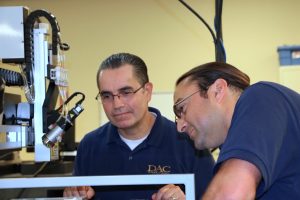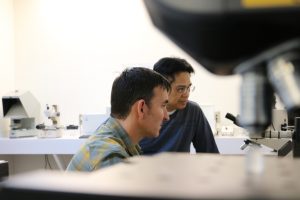The Engineering department is a core competency that DAC relies on to keep pace with new advancements in technology, changing regulatory demands, while at the same time continually increasing value to our customers through the machinery it helps to create.
As DAC customers have to meet stricter regulations with the new MDR, we too as engineers and machine builders must also meet new more stringent regulations and standards. Finding manufacturers and designing components that meet or exceed worldwide, CE, and UL standards is one of the key tasks of the engineering team. Last year, DAC found itself in the unenvious position of having to issue an end of life notice regarding non-serviceable DAC machines. The timing of this allowed DAC to fully leverage resources to meet the increasing demands of CE, UL and local regulatory bodies. DAC worked in conjunction with an internationally recognized regulatory laboratory to ensure compliance and adherence to requirements.
Shaun Snyder, the newest member of the Engineering team, joined DAC in 2015. Shaun noted: “Regulatory requirements, such as CE and UL compliance, are constantly changing and DAC is working hard to ensure we meet all the requirements. Some updates to our products are “under-the-hood” so to speak and not immediately obvious, whereas others are more noticeable. By complying with all current regulatory requirements, we are ensuring – and improving – the overall safety and quality of our products.” Shaun studied mechatronics, combining electronics and mechanical engineering and is uniquely suited to work at DAC as the complicated marriage of electrical and mechanical components are critical to the performance of the equipment.

Edward Seery, the Engineering Director, relies on his team of engineers to meet a wide range of challenges that building precision machines demand. Ed’s background experience includes diagnostic and medical device manufacturing and development, as well as involvement in several start-up companies.
Marc Tolentino and Joseph Alviso, have each, dedicated over 20 years to DAC. Marc started off in the assembly department where after working for several years, he gained a broad knowledge of many aspects of DAC equipment. With this knowledge, he now supports the customer service department by specifying components for upgrades, creating retrofit kits and creating upgrade wiring schematics. In this capacity, he continues to add value to machines that he initially may have helped assemble. When the service department has challenges, Marc also plays a hand supporting the technicians to diagnose and resolve challenges in the field.

Joseph specializes in mechanical design and was the engineering force behind the narrow tool holder that became available in 2017. Joseph commented that “The need of additional specialized tools from our customers demanded that we increase the available area of tooling plate. The narrow tool holder now allows greater flexibility in tooling configurations”. When Joseph is not working on mechanical improvements, he lends his design perspective to shape the aesthetics of the equipment; much of the “look and feel” of the machines are the result of his efforts. The design of frames, granites as well as many other interior and exterior assemblies owe their crisp appearance to Joseph.
With the vision of Ken Payne, as well as additional capital investment by the shareholders in DAC, the Engineering team is excited about the future. One such item that was added to the engineering “toolbox” includes a laser scanning confocal microscope. DAC still utilizes industry standards to gauge the output of our equipment, interferometers, optical microscopes and profilometers, but the laser microscope allows DAC to gain insight at the nanometer scale. Having this tool removes the veil to a whole new level of understanding about the true nature of the forces at work of our equipment at the nanometer scale.
The laser microscope also plays an indispensable role by standardizing definitions and quantifying non-contact surface roughness metrology. The raw data coupled with the stunning images available from the laser microscope helps DAC and the engineering team, scientifically evaluate experiments that push forward advancements in surface roughness, lens design, and machine performance. With better tools, new investments and a clear vision, you can rest assured that valuable and exciting engineering developments are on their way!
